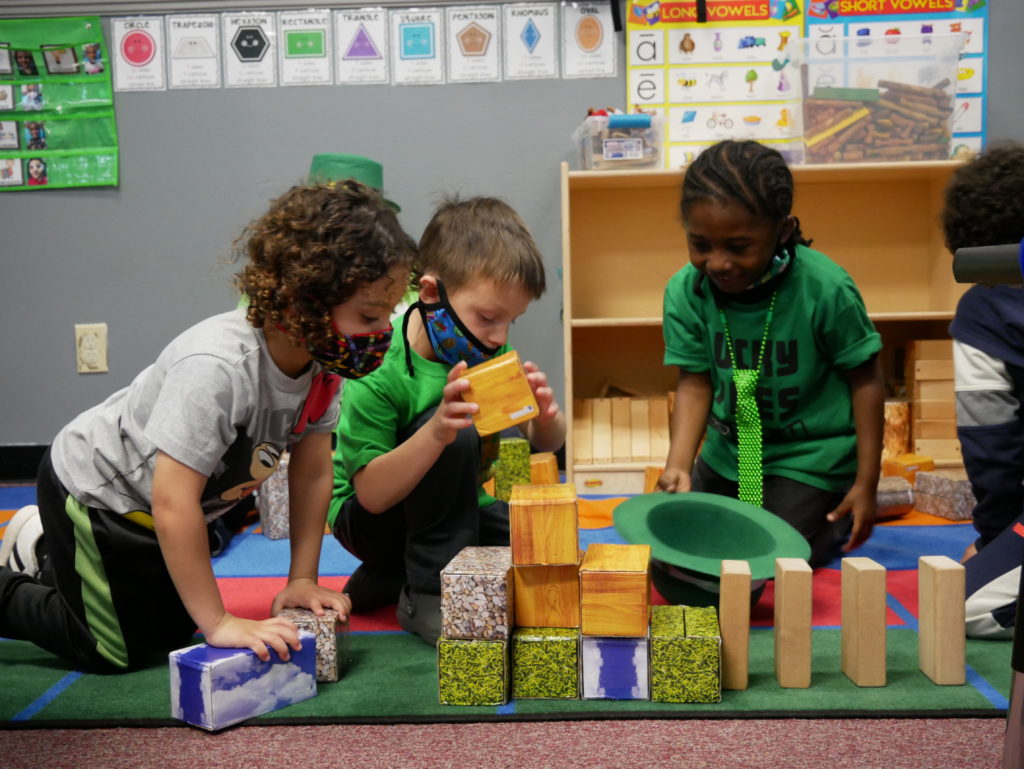Early Bird readers, hello again. Newcomers, welcome! If you were forwarded this email, you can sign up here to receive it every two weeks, and join our conversation on issues facing North Carolina’s young children and those who support them. If you’re already a subscriber, please help us reach more people by sharing this with your friends and co-workers interested in early childhood education.

I hope everyone celebrated St. Patrick’s Day as well as the preschooler with the green tie above. Since the last Early Bird, I’ve been speaking with experts — nonprofit leaders and researchers — about the future of early care and education.
I wrote a piece on CandL, a coalition of organizations, communities, and multidisciplinary leaders traveling to 17 communities to ask parents and early childhood providers what they want and need that future to look like.
“We are forever changed by this pandemic, which revealed just how fragile our current system is and just how many kids are existing outside of it,” said Muffy Grant, executive director of the North Carolina Early Childhood Foundation. “And so what we want to do is broaden the system to be accessible, affordable, and remaining high quality, with cultural responsiveness for all families.”
The group will eventually create an agenda around insights from the tour and launch a multiyear campaign. But first, it is asking how early learning environments can meet families’ needs rather than, “In the current system, where can you fit the least awkwardly?” Grant said.
This work is especially critical as more public investments might make their way into the early childhood system in coming years, Grant said. So is ensuring that our early learning programs are nurturing and make a lasting positive impact on children.
The latter point has been the focus of a conversation here in North Carolina and across the country. I listened to a Duke lecture last week in which researcher Peg Burchinal from the University of Virginia talked about the fade-out of pre-K gains that multiple studies have found. Burchinal’s team looked at NC Pre-K attendees and non-attendees in rural communities and found that certain skills faded more than others.
“Teaching rote skills in pre-K is ineffective,” Burchinal said Tuesday.
Her main conclusion was that pre-K should focus on abstract skills such as language and executive functioning rather than academic content that kindergarten and early grades address. The researchers who authored this Hechinger Report opinion piece had similar points.
But pre-K might not need to be so “either/or,” said Sandra Soliday Hong, a research scientist at UNC-Chapel Hill. Hong told me pre-K teachers can do both if supported with the right materials and research-backed methods. Some academic focus is important for students who face difficulties learning to read, Hong said.
“They need that support to be able to move along with their peers neurologically,” Hong said. “So we could be leaving behind two to four kids in every classroom if we don’t do that.”
If you’re an early childhood educator, researcher, or parent, I’d love to hear your thoughts: What are the most important characteristics of a pre-K program, and how can our state move toward a continuum of care and education that meets children’s needs? Let’s chat.
Early Bird reads: What we’re writing
The question is not whether to provide pre-K, but how, researchers say
The question of Pre-K’s most effective focus is particularly relevant for classrooms across North Carolina this year, as state-mandated training rolls out, aimed at improving knowledge and practice in teaching children to read among teachers from pre-K through fifth grade. Literacy instruction was the most common academic focus in the pre-K classrooms in a recent study.
What are families’ and care providers’ early childhood aspirations? A coalition hits the road to ask
The upcoming listening tour will be facilitated by community-based organizations with help from marketing firm The Link Group.
“We need to be nimble enough to respond to the needs of now and also be prepared for any potential care infrastructure that comes our way, and this work is what is going to sustain our early care and education system,” said Muffy Grant, executive director of the North Carolina Early Childhood Foundation.
In other early learning news: What I’m reading
Which Coronavirus Vaccine Will Work in the Youngest Children? - From The New York Times
Opinion: Critics are wrong. The evidence on NC Pre-K is clear. - From The News & Observer
Evictions, high rents and strict rules plague in-home child care - From The Hechinger Report
Brunswick families scrambling for childcare after preschool closes - From Star News
Research & Resources: Let's talk a $1 trillion family-friendly boost
On International Women’s Day, financial services company Moody’s released a report on the role of female workforce participation in the national economy, estimating a $1 trillion boost in the U.S. GDP over the next 10 years if women were supported with policies that enabled them to work. That would be 4% above the report’s baseline GDP forecast.
These policies, such as paid family leave and subsidized early care and education, would raise women’s participation rate to the levels of countries where those supports exist, such as the U.K., Germany, Australia, and Sweden, the report states.
The report also highlights how the pandemic has disproportionately affected women’s labor force participation in the United States:
- Workforce participation of 25-to-54-year-old women is lower than that of men during those ages everywhere, but the U.S. had the largest gap in the research’s sample group.
- Since the start of the pandemic, the U.S. participation gap has widened while several other countries’ gaps have shrunk.
- A higher proportion of women left the workforce in the U.S. and Canada than in the U.K., Germany, Australia, and Sweden. The report says this is partly due to the lack of family-friendly policies.


